Dynamic Behavior of Ground Improved Using a Crushed Stone Foundation Wall
Abstract
1. Introduction
2. Materials and Methods
2.1. Similitude Law
2.2. Ground and Foundation Installation
2.3. 1 g Shaking Table Experiment Setup
3. Results and Discussion
3.1. Acceleration Analysis
3.2. Response Spectra Analysis
4. Conclusions
- (1)
- Acceleration was observed to be damped from the outside rather than the inside of the foundation wall. The increase in ground stiffness due to the crushed stone wall caused the natural period of the ground to shift into the short-period region. The acceleration inside the foundation was accordingly larger than that outside the foundation.
- (2)
- The distance from the crushed stone was not observed to have a significant influence on ground acceleration under long-period seismic motions. However, the distance from the crushed stone did affect the ground acceleration under short-period seismic motions. Due to the change in the natural period of the ground, acceleration was affected more by short-period seismic motions, and the acceleration changes according to distance can be observed through the obtained slopes of the acceleration–distance curves.
- (3)
- As the distance from the foundation wall increased, the acceleration amplification ratio decreased for all seismic waves. A similar trend in the acceleration amplification ratio of the short-period Northridge- and Loma Prieta-type seismic waves was observed. However, the long-period Hachinohe-type wave exhibited a smaller amplification ratio–distance slope. The effect of the distance from the foundation wall on acceleration amplification was therefore found to be insignificant.
- (4)
- The difference in responses inside and outside the crushed stone foundation wall strips was found to be larger for long-period seismic waves than for short-period seismic waves. The shape of the response spectrum obtained from the accelerometer positioned farthest away from the crushed stone foundation wall was noticeably different than that of the input seismic waves, while the response spectra around the crushed stone foundation wall were observed to be similar to the input seismic waves.
- (5)
- The ground was obviously affected by the installation of the crushed stone structure. When a ground structure such as a crushed stone wall is installed, the period changes due to the change in the ground stiffness, as do the acceleration and response spectra values. When designing the soil-structure for a foundation wall, it is therefore necessary to appropriately consider the effect of the installed crushed stone.
Author Contributions
Funding
Conflicts of Interest
References
- Das, B.M.; Shin, E.C. Strip Foundation on Geogrid-Reinforced Clay: Behavior Under Cyclic Loading. Geotext. Geomembr. 1994, 13, 657–667. [Google Scholar] [CrossRef]
- Kamath, K.; Divya, N.; Rao, A.U. A study on static and dynamic behavior of outrigger structural system for tall buildings. Bonfring Int. J. Ind. Eng. Manag. Sci. 2012, 2, 15–20. [Google Scholar] [CrossRef]
- Delgadillo, R.; Zonno, G.; Boroschek, R.; Lourenco, P.B.; Aguilar, R. Study of the Environmental Influence on the Dynamic Behavior of Adobe Walls: Preliminary Test in Laboratory Specimens. In Proceedings of the International Conference on Experimental Vibration Analysis for Civil Engineering Structures, San Diego, CA, USA, 12–14 July 2017; pp. 758–769. [Google Scholar]
- Yoo, K.S. Compaction Characteristics of Crushed Stones by Cyclic Load. Proc. KSCE J. Civ. Eng. Conf. 2003, 10, 4055–4058. [Google Scholar]
- Lee, S.W.; Youn, C.M.; An, H.H.; Seo, B.W. Interface shear strength between crushed stone and geotextile. J. Kor. Geosynth. Soc. 2006, 5, 33–38. [Google Scholar]
- Shim, W.B.; Kwon, Y.G.; Hong, K.N.; Han, S.H. Comparison of Shape Characteristics between Coarse Aggregate by Computational Dynamic Generation Modeled and Crushed Stone. Proc. Korea Concr. Inst. Fall Conf. 2013, 10, 785–786. [Google Scholar]
- Seed, H.B.; Idriss, I.M. Analysis of Soil Liquefaction: Niigata Earthquake. J. Soil Mech. Found. 1967, 93, 83–108. [Google Scholar]
- Seed, H.B.; Idriss, I.M. Simplified Procedure for Evaluating Soil Liquefaction Potential. J. Soil Mech. Found. Div. 1971, 97, 1249–1273. [Google Scholar]
- Seed, H.B.; Lee, K.L.; Idriss, I.M.; Makdisi, F.I. The Slides in the San Fernando Dams During the Earthquake of February 9, 1971. J. Geotech. Eng. Div. 1975, 101, 651–688. [Google Scholar]
- Seed, H.B.; Booker, J.R. Stabilisation of Potentially Liquefiable Sand Deposits Using Gravel Drain Systems; Report No. EERC76-10; U.C. Berkeley: Berkeley, MA, USA, 1976. [Google Scholar]
- Baez, J.I. A Design Model for the Reduction of Soil Liquefaction by Vibro Stone Columns. Ph.D. Thesis, University of Southern California, Los Angeles, CA, USA, 1995. [Google Scholar]
- Goughnour, R.R.; Pestana, J.M. Mechanical Behavior of Stone Columns Under Seismic Loading. In Proceedings of the 2nd International Conference on Ground Improvement Techniques, Singapore, 7–10 October 1998; pp. 157–162. [Google Scholar]
- Timothy, C.S.; William, M.C.; Chang, C.C.; Marcos, L. Site response of improved ground in the coastal eastern United States. In Proceedings of the 4th International Conference on Ground Improvement Techniques, Kuala Lumpur, Malaysia, 26–28 March 2002. [Google Scholar]
- Adalier, K.; Elgamal, A.; Meneses, J.; Baez, J.I. Stone columns as liquefaction countermeasure in non-plastic silty soils. Soil Dyn. Earthq. Eng. 2003, 23, 571–584. [Google Scholar] [CrossRef]
- Adalier, K.; Elgamal, A. Stone Column Remediation of Liquefiable Silty Marine Foundation Deposits. In Proceedings of the Twenty-first International Offshore and Polar Engineering Conference, Maui, HI, USA, 19–24 June 2011; pp. 686–691. [Google Scholar]
- Adalier, K.; Elgamaz, B. Mitigation of liquefaction and associated ground deformations by stone columns. Eng. Geol. 2004, 72, 275–291. [Google Scholar] [CrossRef]
- Zhan, Y.; Jiang, G.; Yao, H. Dynamic characteristics of saturated silty soil ground treated by stone column composite foundation. Adv. Mater. Sci. Eng. 2014. [Google Scholar] [CrossRef]
- Buckingham, E. On Physically Similar Systems; Illustrations of the Use of Dimensional Equations. Phys. Rev. 1914, 4, 345–376. [Google Scholar] [CrossRef]
- Ling, X.Z.; Wang, C.; Wang, C. Scale modeling method of shaking table test of dynamic interaction of pile-soil-bridge structure in ground of soil liquefaction. Chin. J. Rock Mech. Eng. 2004, 23, 450–456. [Google Scholar]
- Kim, J.M.; Lee, H.J.; Ryu, J.H. Seismic response of stone column-improved soft clay deposit by using 1g shaking table. J. Kor. Geotech. Soc. 2010, 26, 61–70. [Google Scholar]
- Kim, J.M.; Ryu, J.H.; Kim, M.N.; Son, S.W. 1g shaking table test on soil and stone-column interaction behavior under seismic loading. J. Korean Geotech. Soc. 2012, 28, 115–124. [Google Scholar] [CrossRef][Green Version]
- Castro, J. Modeling stone columns. Materials 2017, 10, 782. [Google Scholar] [CrossRef]
- Kardgar, H. Investigation of the bearing capacity of foundations on encased stone columns using finite element method. Int. J. Integr. Eng. 2018, 10, 103–108. [Google Scholar] [CrossRef]
- Das, M.; Dey, A.K. Prediction of bearing capacity of stone columns placed in soft clay using ANN model. Geotech. Geol. Eng. 2018, 36, 1845–1861. [Google Scholar] [CrossRef]
- Kim, J.M.; Ryu, J.H.; Son, S.W.; Na, H.Y.; Son, J.W. A comparative study on dynamic behavior of soil containers that have different side boundary conditions. J. Kor. Geotech. Soc. 2011, 27, 107–116. [Google Scholar] [CrossRef]
- Kramer, S.L. Geotechnical Earthquake Engineering; Prentice Hall: Upper Saddle River, NJ, USA, 1996. [Google Scholar]
- Meymand, P.J. Shaking Table Scale Model Tests of Nonlinear Soil-Pile-Superstructure Interaction In Soft Clay. Ph.D. Thesis, University of California, Berkeley, MA, USA, 1998. [Google Scholar]
- Iai, S. Similitude for Shaking Table Tests on Soil-Structure-Fluid Model In 1g Gravitational Field. Jpn. Soc. Mech. Found. Eng. Soils Found. 1989, 29, 105–118. [Google Scholar] [CrossRef]
- Gibson, A.D. Physical Scale Modeling of Geotechnical Structures at One-G. Ph.D. Thesis, California Institute of Technology, Pasadena, CA, USA, 1996. [Google Scholar]
- Kagawa, T. On the Similitude in Model Vibration Tests of Earth Structures, Soil Mechanics and Foundation Engineering. Proc. Jpn. Soc. Civ. Eng. 1978, 275, 69–77. [Google Scholar] [CrossRef]
- Kokusho, T.; Iwatate, T. Scaled model tests and numerical analyses on nonlinear dynamic response of soft grounds. Proc. Jpn. Soc. Civ. Eng. 1979, 285, 57–67. [Google Scholar] [CrossRef]
- Rocha, M. The Possibility of Solving Soil Mechanics Problems by the Use of Models. 1958, 183–188. Available online: https://www.issmge.org/uploads/publications/1/41/1957_01_0041.pdf (accessed on 15 May 2019).
- Chopra, A.K. Dynamic of Structures, Theory and Apllications to Earthquake Engineering; Prentice Hall: New Jersey, NJ, USA, 1995. [Google Scholar]
- Hashash, Y.M.A.; Musgrove, M.I.; Harmon, J.A.; Groholski, D.R.; Phillips, C.A.; Park, D. DEEPSOIL 6.1, User Manual; University of Illinois at Urbana-Champaign: Urbana, IL, USA, 2016. [Google Scholar]
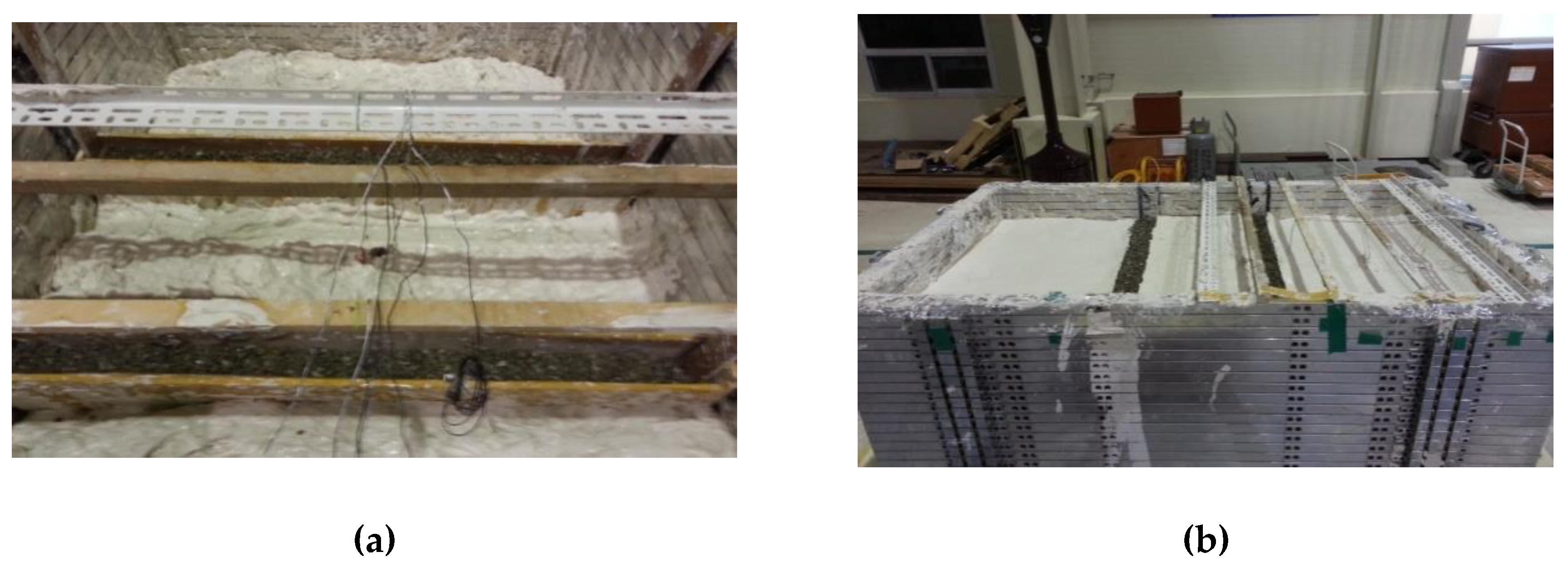
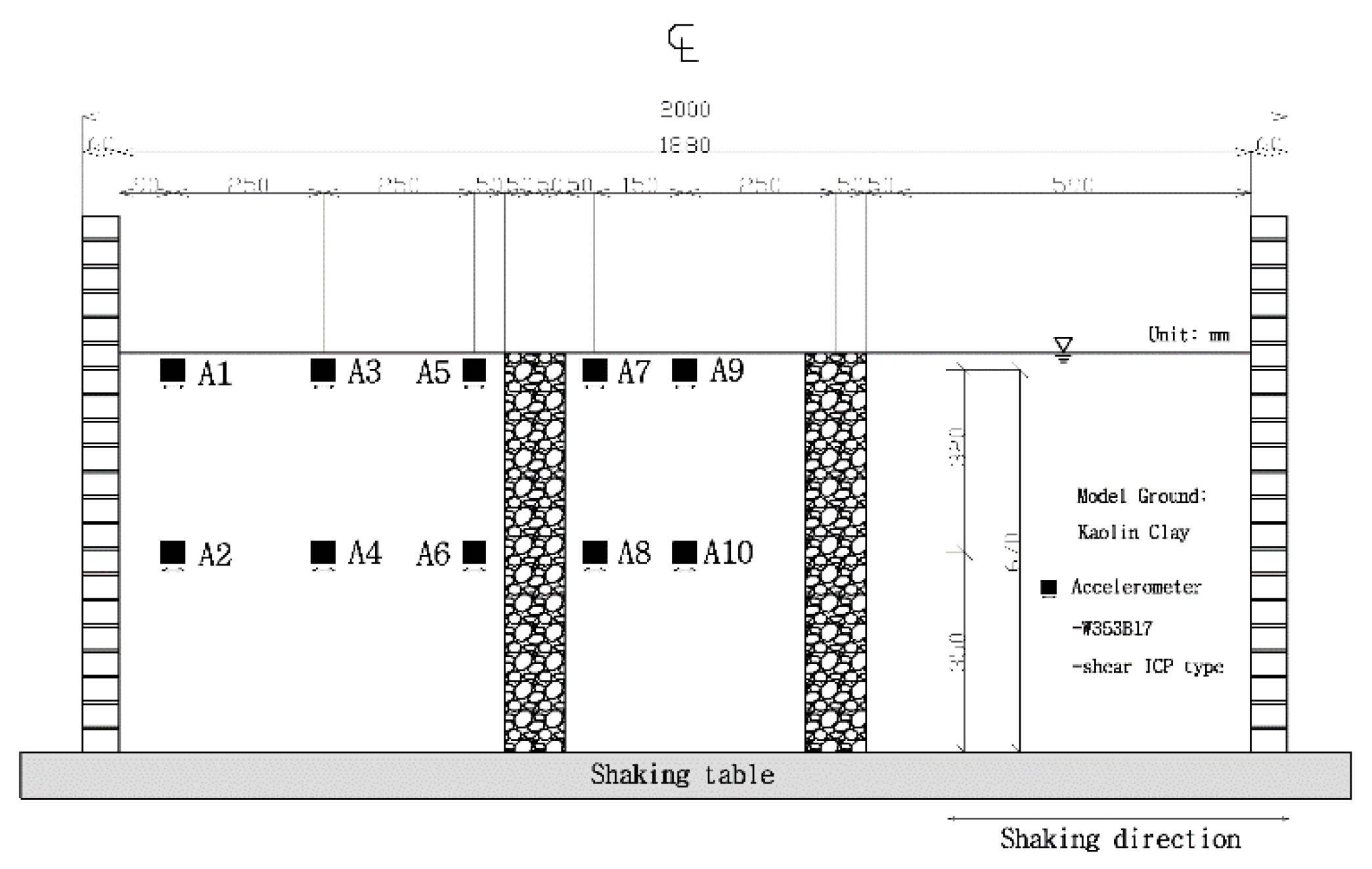
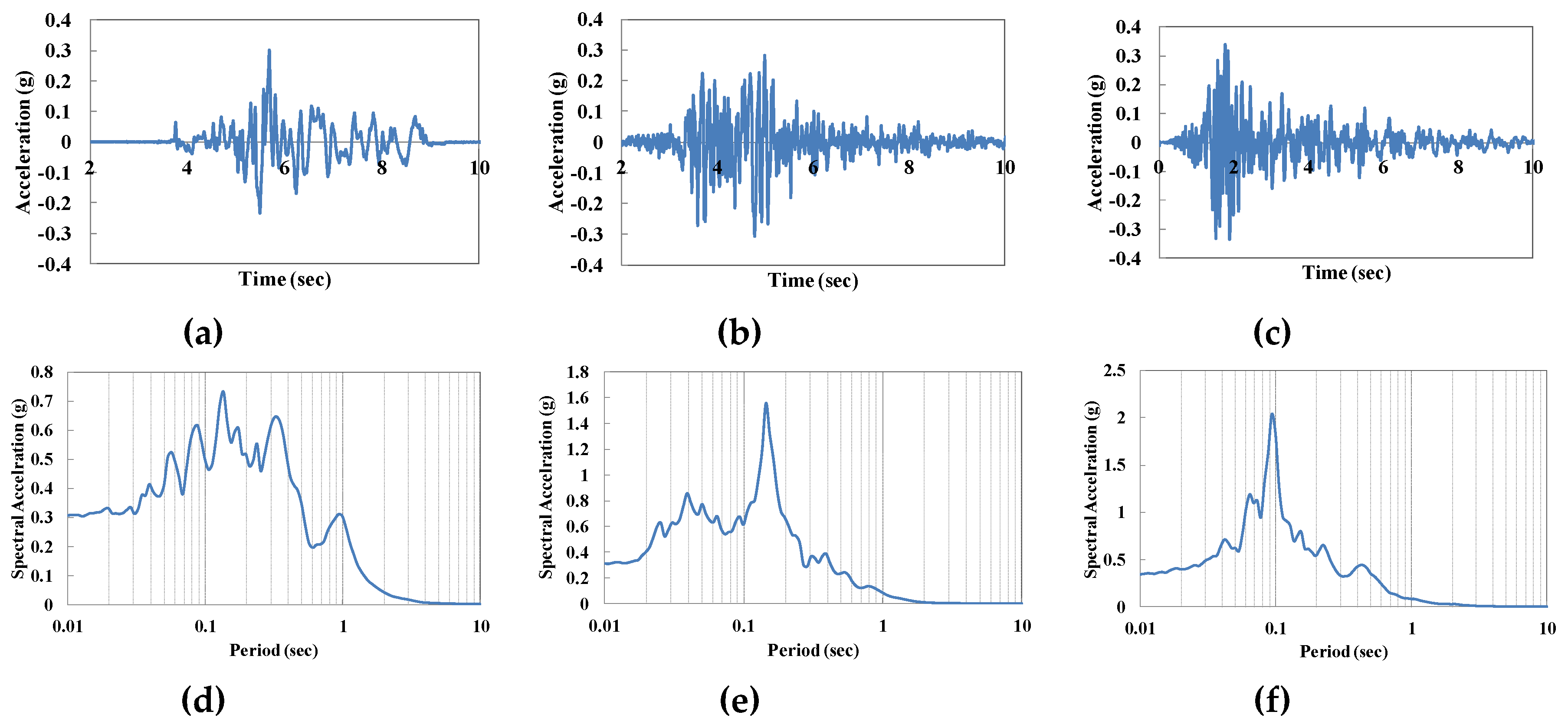
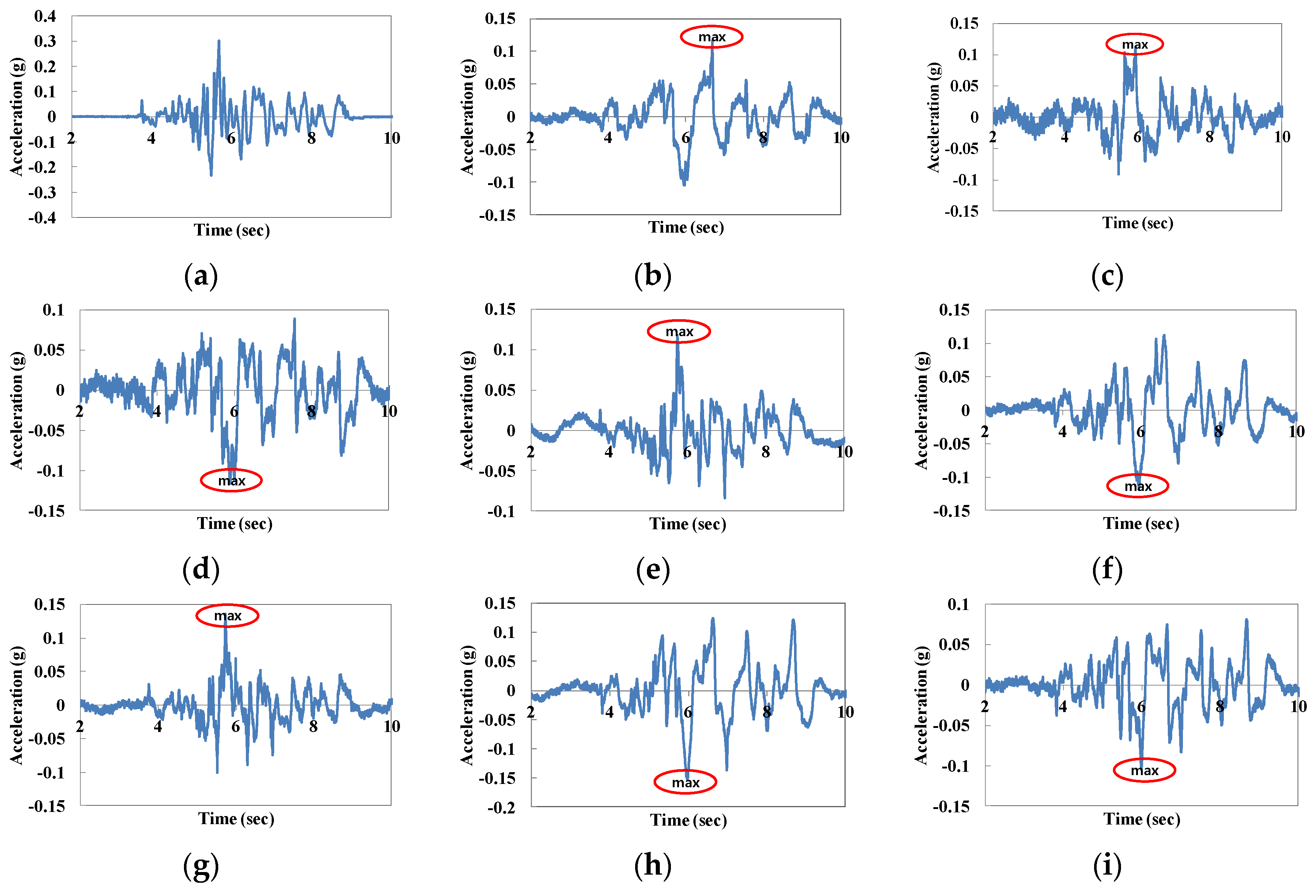
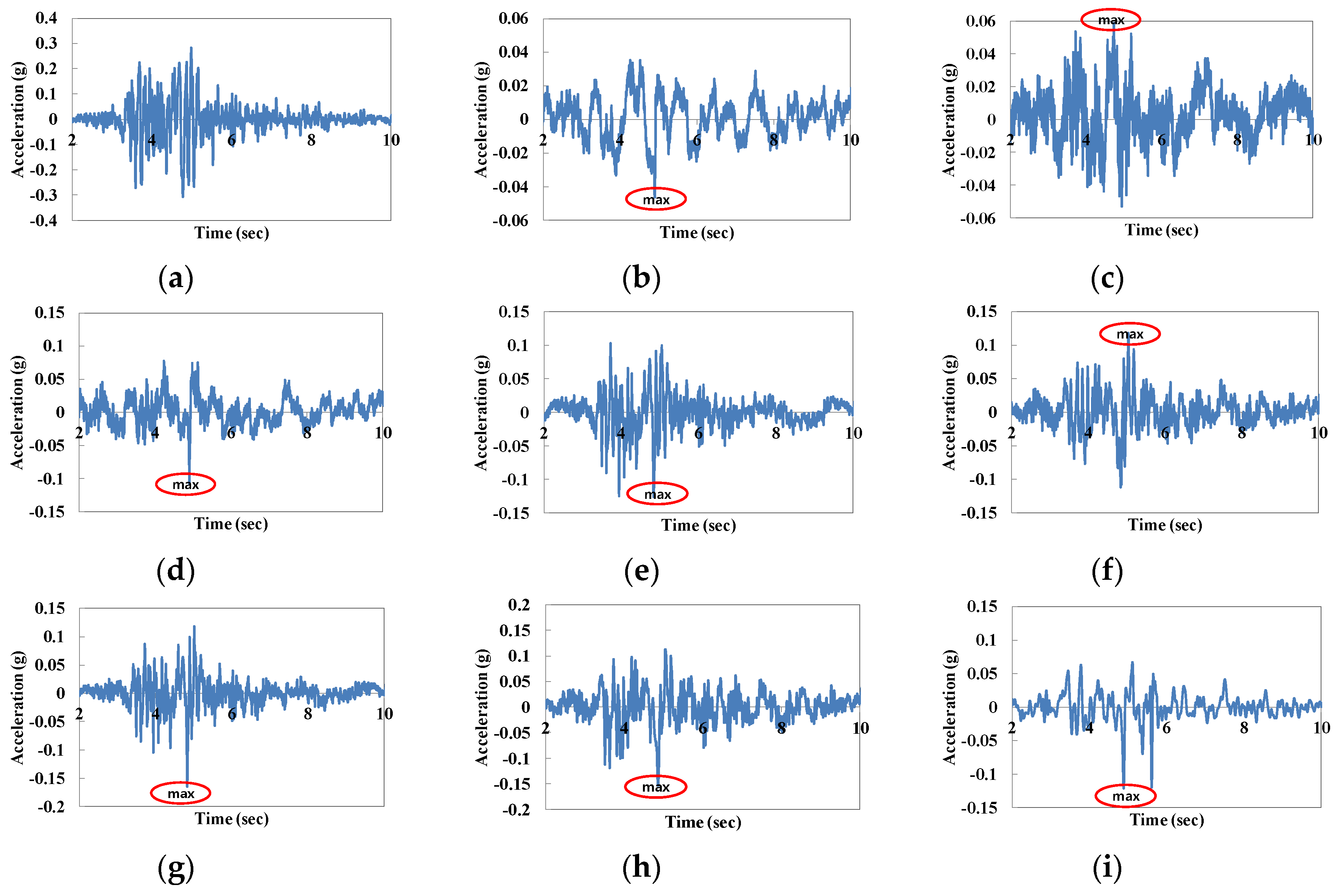
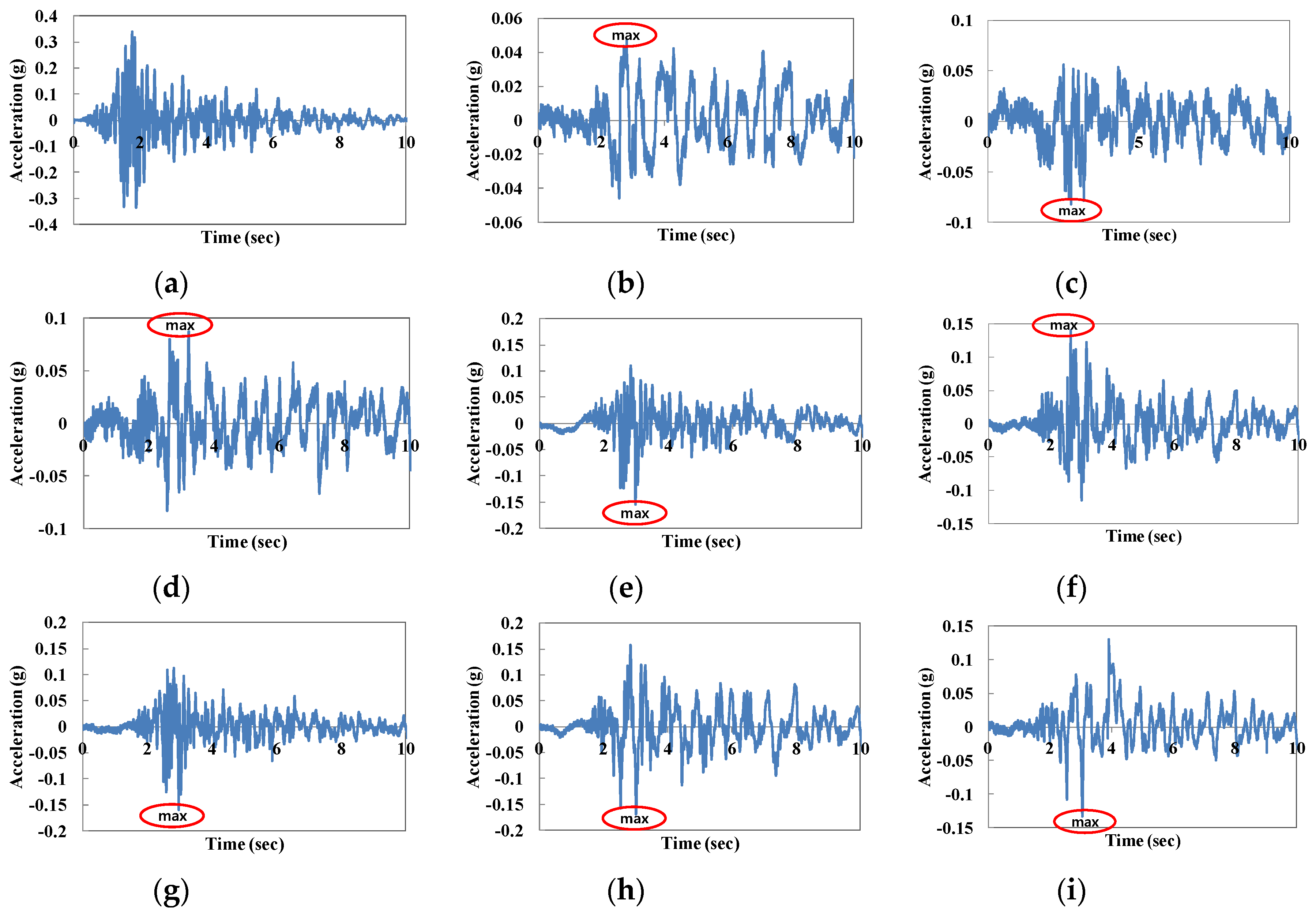




| Generalized Parameter | Type 3 | ||
|---|---|---|---|
| λε = 1, λρ = 1 | |||
| Length | Λ | λ | 7 |
| Density | λρ | 1 | 1 |
| Time | (λλε)0.5 | λ0.5 | 2.65 |
| Acceleration | 1 | 1 | 1 |
| Velocity | (λλε)0.5 | λ0.5 | 2.65 |
| Displacement | λλε | λ | 7 |
| Stress | λλρ | λ | 7 |
| Strain | λε | 1 | 1 |
| Stiffness | λλρ/λε | λ | 7 |
| Parameter | Clay | Crushed Stone |
|---|---|---|
| Undrained shear strength (kPa) | 5 | 10 |
| Unit weight (kN/m3) | 16 | 22 |
© 2019 by the authors. Licensee MDPI, Basel, Switzerland. This article is an open access article distributed under the terms and conditions of the Creative Commons Attribution (CC BY) license (http://creativecommons.org/licenses/by/4.0/).
Share and Cite
Son, S.-W.; Bagheri, P.; Kim, J.-M. Dynamic Behavior of Ground Improved Using a Crushed Stone Foundation Wall. Sustainability 2019, 11, 2767. https://doi.org/10.3390/su11102767
Son S-W, Bagheri P, Kim J-M. Dynamic Behavior of Ground Improved Using a Crushed Stone Foundation Wall. Sustainability. 2019; 11(10):2767. https://doi.org/10.3390/su11102767
Chicago/Turabian StyleSon, Su-Won, Pouyan Bagheri, and Jin-Man Kim. 2019. "Dynamic Behavior of Ground Improved Using a Crushed Stone Foundation Wall" Sustainability 11, no. 10: 2767. https://doi.org/10.3390/su11102767
APA StyleSon, S.-W., Bagheri, P., & Kim, J.-M. (2019). Dynamic Behavior of Ground Improved Using a Crushed Stone Foundation Wall. Sustainability, 11(10), 2767. https://doi.org/10.3390/su11102767





